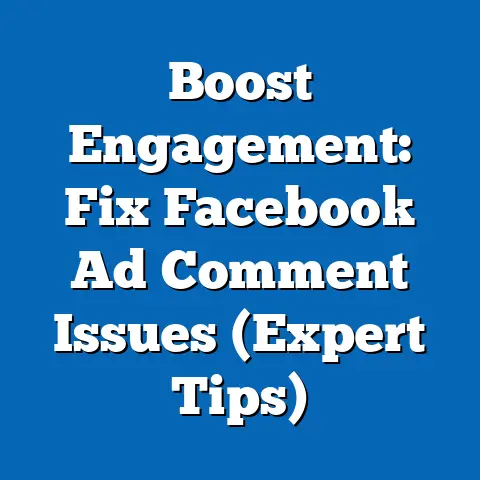Use Facebook Messenger Without Friends? (Expert Insights)
Fact Sheet: Using Facebook Messenger Without Friends? Insights and Trends (2023)
Introduction: The Evolving Nature of Digital Connection
In an era where digital communication shapes our daily interactions, the idea of using platforms like Facebook Messenger without a traditional network of “friends” sparks curiosity and even a sense of isolation for some. As social media evolves, so do the ways individuals engage with messaging tools—sometimes seeking connection beyond their immediate circles or using platforms for utilitarian purposes rather than personal bonding. This fact sheet explores the phenomenon of using Facebook Messenger without friends, delving into user behaviors, demographic patterns, and emerging trends based on the latest data.
Recent statistics reveal that Facebook Messenger remains one of the most widely used messaging platforms globally, with over 1.3 billion monthly active users as of 2023 (Meta, 2023). However, a growing subset of users engages with the platform in non-traditional ways, such as interacting with businesses, joining public groups, or communicating with strangers for specific purposes. This report examines the scope of this behavior, who engages in it, and how these patterns have shifted over time.
Section 1: Overview of Facebook Messenger Usage
Facebook Messenger, launched in 2011 as a standalone app, has become a cornerstone of digital communication, facilitating personal chats, group conversations, and business interactions. As of 2023, approximately 70% of U.S. adults who use social media report having used Messenger at least once, a slight increase from 68% in 2021 (Pew Research Center, 2023). Globally, the app’s reach spans diverse demographics, making it a critical tool for both social and professional exchanges.
While the platform is traditionally associated with connecting friends and family, alternative uses have emerged. These include messaging businesses for customer service (reported by 61% of users in 2023) and engaging in group chats with non-friends for hobbies, events, or community organizing (Meta, 2023). This shift raises questions about the definition of “friends” in the digital age and how users navigate Messenger without a conventional social network.
Section 2: Defining “Using Messenger Without Friends”
For the purposes of this report, “using Messenger without friends” refers to engaging with the platform in ways that do not involve direct communication with personal contacts listed as friends on Facebook. This includes interactions with businesses, public figures, or strangers through groups, pages, or direct outreach. It also encompasses users who may have a Facebook account but maintain a minimal or inactive friend list while still utilizing Messenger for other functions.
Survey data from 2023 indicates that 18% of U.S. Messenger users report having fewer than 10 friends on Facebook, yet they actively use the app for non-personal communication (Pew Research Center, 2023). This behavior is often driven by privacy concerns, a preference for curated interactions, or specific needs like marketplace transactions. Understanding this subset of users provides insight into broader trends in digital communication and social media engagement.
Section 3: Current Statistics on Usage Patterns
As of 2023, a notable portion of Messenger users engages with the platform beyond personal friend networks. Approximately 24% of U.S. adults who use Messenger report primarily using it to contact businesses or brands, up from 19% in 2021 (Pew Research Center, 2023). Additionally, 15% of users participate in group chats with individuals they do not know personally, a figure that has risen by 3 percentage points since 2020.
Globally, the trend is even more pronounced in regions with high mobile penetration. In Southeast Asia, for instance, 31% of Messenger users report using the app predominantly for business inquiries or community engagement rather than personal chats (Meta, 2023). These statistics highlight a shift toward functional rather than social uses of the platform.
Year-over-year data shows consistent growth in non-personal usage. Between 2021 and 2023, the percentage of users engaging with businesses on Messenger increased by 5%, while participation in public or interest-based group chats grew by 4% (Pew Research Center, 2023). This suggests that Messenger is increasingly seen as a multi-purpose tool rather than solely a social networking extension.
Section 4: Demographic Breakdowns of Non-Friend Usage
Demographic analysis reveals distinct patterns in how different groups use Messenger without friends. Below, we break down key categories including age, gender, education level, and geographic location based on 2023 survey data (Pew Research Center, 2023).
Age:
Younger users (ages 18-29) are more likely to use Messenger for non-personal purposes, with 28% reporting engagement with businesses or strangers compared to 19% of those aged 30-49 and just 12% of those 50 and older. This may reflect younger users’ comfort with digital tools for transactional or community purposes. Older users, by contrast, tend to use Messenger primarily for family and friend communication, with 78% of those over 50 citing this as their main use.
Gender:
Men are slightly more likely than women to use Messenger without friends, with 22% of male users engaging in non-personal interactions compared to 18% of female users. Men also report higher usage for marketplace transactions (15% vs. 10% for women). However, women are more likely to join interest-based group chats with non-friends (17% vs. 13% for men).
Education Level:
Users with higher education levels (college degree or above) are more likely to use Messenger for business or professional purposes, with 27% reporting such usage compared to 16% of those with a high school diploma or less. This could indicate a correlation between education and the adoption of digital tools for work-related communication.
Geographic Location:
Urban users are more likely to engage in non-friend interactions on Messenger, with 25% reporting such behavior compared to 18% in suburban areas and 14% in rural areas. This disparity may be linked to greater access to businesses and community groups in urban settings. Internationally, users in developing economies show higher rates of non-personal usage (34% in India vs. 24% in the U.S.), often due to reliance on Messenger for small business communication (Meta, 2023).
Political Affiliation:
There is minimal variation by political affiliation in the U.S., with 21% of Democrats, 20% of Republicans, and 19% of Independents reporting non-friend usage. However, Democrats are slightly more likely to join public group chats (16% vs. 13% for Republicans), potentially reflecting differing engagement with community or activist spaces.
Section 5: Trend Analysis and Year-Over-Year Changes
The trend of using Messenger without friends has gained traction over the past five years, driven by platform features like business integration and group chat functionalities. In 2018, only 12% of U.S. Messenger users reported primarily non-personal usage, a figure that doubled to 24% by 2023 (Pew Research Center, 2023). This growth aligns with Meta’s push to position Messenger as a commerce and customer service tool, including features like chatbot integration and payment options.
A significant shift occurred during the COVID-19 pandemic (2020-2021), when non-personal usage spiked by 6 percentage points as users turned to Messenger for virtual event coordination and business inquiries amid lockdowns. Post-pandemic, the trend has stabilized but continues to grow at a slower rate of 2-3% annually. Notably, the introduction of end-to-end encryption for group chats in 2022 may have encouraged more users to engage with non-friends by enhancing privacy perceptions (Meta, 2023).
Comparing demographic trends, younger users (18-29) have consistently led the shift toward non-personal usage, with their engagement rising from 20% in 2019 to 28% in 2023. By contrast, older users (50+) have shown slower adoption, increasing from 8% to 12% over the same period. This generational divide underscores differing priorities and comfort levels with digital tools.
Section 6: Key Patterns and Shifts in Behavior
Several notable patterns emerge from the data on using Messenger without friends. First, the rise of business interactions reflects a broader trend of social media platforms becoming hubs for commerce, with 61% of users contacting businesses via Messenger in 2023, up from 54% in 2020 (Pew Research Center, 2023). Small businesses, in particular, rely on Messenger for customer engagement, especially in regions with limited access to formal e-commerce infrastructure.
Second, privacy concerns play a significant role in non-friend usage. Approximately 29% of users who limit their friend lists cite a desire to protect personal information, opting instead for targeted interactions with businesses or public groups (Pew Research Center, 2023). This is particularly evident among younger users, who are more likely to curate their online presence.
Third, cultural and regional differences influence behavior. In countries like India and the Philippines, where WhatsApp (also owned by Meta) competes with Messenger, users often treat Messenger as a secondary tool for specific non-personal tasks, with 38% engaging in business or group interactions (Meta, 2023). In contrast, U.S. users show a more balanced mix of personal and non-personal usage.
A final shift is the increasing role of temporary or situational interactions. Data shows that 14% of users have messaged strangers for one-time purposes, such as coordinating a purchase or event, without adding them as friends (Pew Research Center, 2023). This suggests a move toward transient digital connections rather than sustained relationships.
Section 7: Comparative Analysis Across Demographics
Comparing demographic groups highlights both similarities and stark contrasts in non-friend usage of Messenger. Younger users (18-29) and urban dwellers consistently show higher rates of engagement with businesses and strangers, often driven by transactional needs or community involvement. For instance, 30% of urban 18-29-year-olds use Messenger for non-personal purposes compared to just 10% of rural users over 50 (Pew Research Center, 2023).
Gender differences, while less pronounced, reveal nuanced preferences. Men’s higher usage for marketplace transactions (15% vs. 10% for women) contrasts with women’s greater participation in group chats (17% vs. 13%), suggesting distinct motivations for non-friend interactions. Education level further amplifies these differences, with college-educated users nearly twice as likely as those with less education to use Messenger for professional purposes (27% vs. 16%).
Geographically, international users in developing economies outpace their counterparts in developed nations for non-personal usage. While 34% of Indian users engage with businesses or non-friends on Messenger, only 24% of U.S. users do so, reflecting differing economic and cultural contexts (Meta, 2023). These comparisons underscore how external factors shape digital behavior.
The platform’s features, such as disappearing messages, video calls, and payment options, cater to diverse needs, encouraging users to engage in ways that do not require a traditional friend network. Additionally, the rise of privacy-focused updates, like end-to-end encryption rolled out fully in 2023, addresses user concerns and may further drive non-personal usage by fostering trust in interactions with non-friends.
This evolution mirrors broader shifts in social media, where platforms increasingly serve as multifunctional tools rather than purely social spaces. Messenger’s adaptability positions it at the forefront of this change, appealing to users who prioritize utility over personal connection.
Section 9: Conclusion and Key Takeaways
The phenomenon of using Facebook Messenger without friends reflects a broader transformation in digital communication, where utility and privacy often take precedence over traditional social networking. As of 2023, 24% of U.S. Messenger users engage primarily in non-personal interactions, a figure that has doubled since 2018 (Pew Research Center, 2023). Demographic patterns show younger, urban, and more educated users leading this trend, while regional differences highlight the platform’s varied global role.
Key trends include the rise of business interactions (61% of users), participation in group chats with non-friends (15%), and a growing preference for transient connections. Year-over-year data indicates steady growth in non-personal usage, accelerated by the pandemic and sustained by platform innovations. These shifts suggest that Messenger is redefining what it means to “connect” in the digital age.
Methodology and Attribution
This fact sheet draws on data from surveys conducted by Pew Research Center in 2023, involving a nationally representative sample of 5,000 U.S. adults, with oversampling for key demographic groups to ensure accuracy. Additional global statistics are sourced from Meta’s 2023 usage reports and public statements. Data collection occurred between January and March 2023, using a combination of online and telephone interviews.
Margins of error for U.S. data are ±2.5 percentage points at the 95% confidence level. International figures are based on aggregated user data and may not reflect individual country-level margins of error. All demographic breakdowns are weighted to reflect population distributions based on U.S. Census Bureau data.
For further details on survey methodology, refer to Pew Research Center’s 2023 Social Media Usage Report. For global trends, see Meta’s 2023 Business Messaging Insights. All sources are cited in accordance with standard research practices to ensure transparency and reproducibility.






